The Best Destinations for Scuba Diving in February
For divers north of the equator, the itch to escape the cold and get back into the water is serious come February. Luckily, the second month of the year offers some of the best dive conditions in warm, tropical locations like the Caribbean, Thailand, and Indonesia. The hardest part is choosing your destination. To help guide your upcoming scuba diving travel planning, we have selected five of our favorite dive destinations for February!
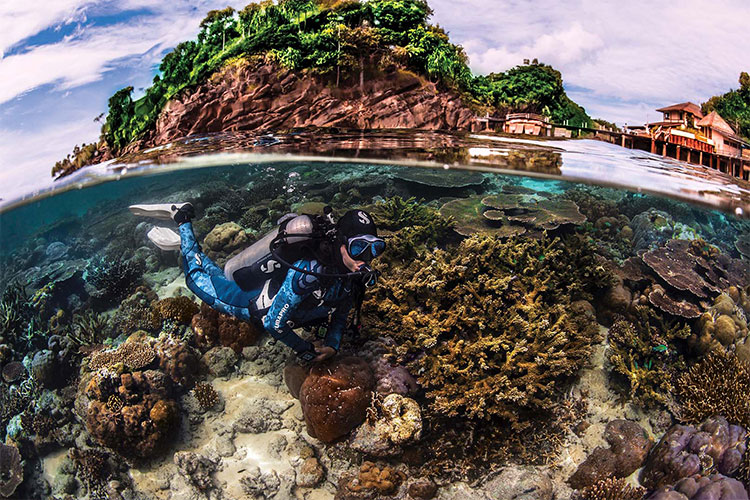
RAJA AMPAT
Raja Ampat is widely regarded as one of the world’s best dive destinations, and for good reason. Located in the heart of Indonesia’s Coral Triangle, Raja Ampat is home to more than 500 species of coral and more than 1,000 species of fish, making it one of the most biodiverse marine ecosystems in the world. In fact, divers have reported seeing more than 200 species of fish on a single tank.
Whether it’s big animals or macro critters that you’re looking for, Raja Ampat delivers in spades. Raja’s virtually untouched reefs are awash with colorful soft corals buzzing with marine life. The reefs are home to butterflyfish, basslets, angelfish, clownfish, and even the occasional whitetip shark. Macro divers flock to the area to capture sightings of vibrant nudibranchs, blue-ribbon eels, and – if they’re lucky – blue-ringed octopus.
Raja Ampat’s diving season spans from October to April, and divers who visit in February are treated to warm waters, minimal rainfall, and calm conditions. (Not to mention incredible visibility.) But the true magic of visiting in February is the opportunity to encounter not one, but two species of manta rays. Raja Ampat is one of the few places in the world where both Reef and Giant manta rays can be observed, and February marks the overlap in the pelagics’ migratory patterns.
Raja Ampat Can’t Miss Dive Sites:
Manta Sandy: Perfect for divers of all skill levels, the shallow waters of Manta Sandy are rife with plankton and serve as a cleaning station for manta rays. As such, encounters with these incredible pelagics are nearly guaranteed on every dive. And thanks to its shallow depths, you won’t be limited on bottom time with the gentle giants.
Sardine Reef: For advanced divers, there’s no site quite as magical as Sardine Reef. Offering a first-hand look at Raja Ampat’s incredible biodiversity, Sardine Reef draws not only its namesake species, but also whitetip, blacktip, and wobbegong sharks, as well as massive schools of bannerfish. As you fin along the oval-shaped coral formation, you’ll encounter vibrant clownfish, butterflyfish, and three species of pygmy seahorse.
Arborek Jetty: Lose yourself in massive schools of fish beneath the iconic Arborek Jetty. The site is known for its bright coral formations and macro critters like pipefish, cuttlefish, and octopus, but the real magic of this site is finding yourself in the middle of a baitball so thick that it blocks your view of anything else.
Travel Tip: The single best way to explore the incredible underwater offerings of Raja Ampat is via liveaboard. Navigating the various islands in the archipelago is easiest by boat, and local operators can provide expert advice to make each dive more enjoyable.
Dive Conditions: Raja Ampat is a year-round dive destination, but the best time of year to visit is between October and April, and February often sees fewer rain showers and relatively smooth seas. February also offers the opportunity to encounter both Reef and Giant mantas during your trip. Water temperatures stay consistently between the high-70s and low 80s, and topside temperatures average in the 80s as well.
Essential Gear: Thanks to Raja Ampat’s consistently warm weather and water temperatures, divers need minimal exposure protection. We recommend bringing a 1mm Tropical Steamer or 2mm Sport Shorty to keep you comfortable during your bottom time, and since you won’t need booties, you can grab your GO Sport Fins to keep your travel bag light.
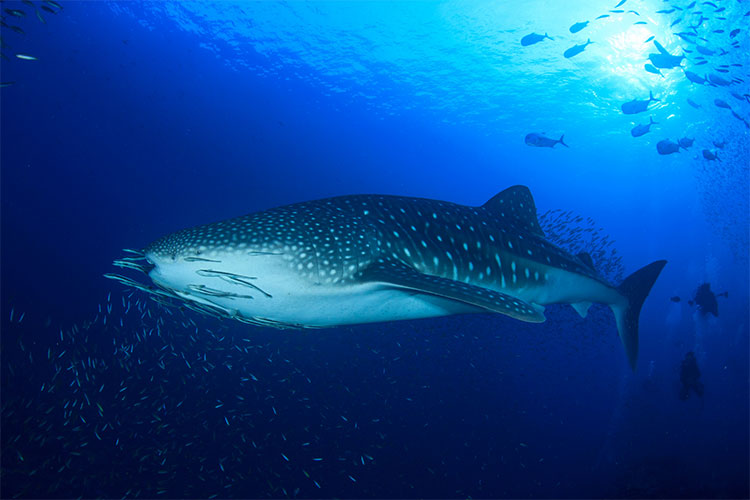
SIMILAN ISLANDS
To experience the best diving Thailand has to offer, we recommend a visit to the Similan Islands. This archipelago in the Andaman Sea is made up of 9 granite islands and was designated a National Park in 1982. The area’s protected status offers diver exceptional underwater experiences among thriving coral reefs. Descending into the gin-clear waters on the archipelago’s east coast reveals a living rainbow of coral and marine life, and the west coast offers advanced divers an underwater playground of canyons, tunnels, and caverns to explore.
February statistically sees very little rainfall in the Similan Islands, which means exceptional visibility and calm conditions for divers to enjoy. February also marks the beginning of pelagic season in the area, so keep an eye out for manta rays and whale sharks during your dives.
Similan Islands Can’t Miss Dive Sites:
Elephant Head: Elephant Head Rock is one of the most recognizable dive sites in the Similan Islands, as its namesake rock formation sits well above the surface and creates an archway in low tide. Below the surface, the rock formations are even more impressive: swim-throughs and tunnels carpeted in soft corals provide cover for marine life, and divers can spot sharks and sea turtles as they swim by.
Richelieu Rock: If you’re looking for big-animal encounters, make sure Richelieu Rock is on your itinerary. Whale sharks frequent this iconic dive site in February, along with manta rays, and schools of trevally and barracuda. Even without the big guys, divers can expect a diverse array of marine life including seahorses, harlequin shrimp, and frogfish.
Christmas Point: Named for its colorful coral reefs, Christmas Point is an incredible site for divers of all skill levels. Underwater archways are decorated with stunning coral formations, and your bottom time will reveal abundant marine life, including garden eels, shrimps, cuttlefish, and nurse sharks.
Travel Tip: The Similan Islands are only open for divers from November through May, and February offers the best chances of encounters with big animals. Diving is accessible via local dive shops and liveaboards.
Dive Conditions: Water temperatures range between 78-84 degrees, with February seeing the warmer end of the spectrum. Topside temperatures average in the 80s as well, and visibility can easily exceed 100 feet. Currents tend to be mild, but tend to pick up toward the end of February.
Essential Gear: Divers who aren’t prone to cold will be comfortable in a 3mm wetsuit, but if you’re doing multiple dives in a day, you may want to opt for something thicker. We recommend bringing your Everflex Steamer for optimum comfort and maneuverability underwater.
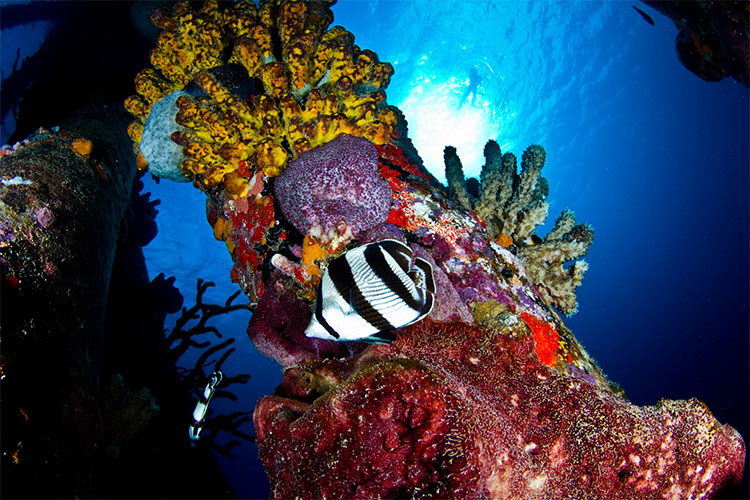
BONAIRE
Any savvy diver knows that Bonaire is a bucket-list destination. With more than 60 marked dive sites accessible by shore, Bonaire has a well-earned reputation as the shore-diving capital of the world. Located just north of Venezuela, Bonaire is the “B” in the Caribbean’s ABC islands, neighbored by Aruba and Curacao. Its Caribbean location makes it a great dive any time of the year, but visiting in February offers a warm winter escape and incredible conditions.
Since 1976, the island’s pristine waters have been protected by the Bonaire National Marine Park, and a portion of every dive permit in Bonaire is donated to ensure the continued protection of its incredible ecosystem. Divers can expect to see a kaleidoscope of colors along the protected reef, including vibrant orange elephant-ear sponges, purple tube sponges, and golden staghorn coral trees. The marine life is equally stunning, and divers are guaranteed encounters with angelfish, strawberry grouper, squirrelfish, parrotfish, butterfly fish, eels, and – for night divers – giant silver tarpon. For patient macro photographers, the reefs surrounding Bonaire can offer sightings of elusive red-lipped blennies and tiny octopuses hidden amongst the corals.
Bonaire Can’t Miss Dive Sites:
1,000 Steps: Don’t let the name intimidate you, accessing this incredible dive does not require a long-distance hike with your gear. The site was named for its iconic staircase – which is only 60 steps – but after your dive, those 60 steps may as well be 1,000. Don’t let that deter you: the reefscape that awaits at 1,000 is an incredible display of Bonaire’s biodiversity.
Klein Bonaire: Just because Bonaire offers unlimited shore diving, divers would be remiss to ignore the incredible sites accessible only by boat on Klein Bonaire. This satellite island offers 26 incredible dives, and – like the mainland – its waters are protected by the Bonaire National Marine Park. Selecting virtually any of Klein Bonaire’s dive sites will yield candy-colored reefs and staggering drop-offs, making it ideal for underwater photography and videography.
Hilma Hooker: A dive trip to Bonaire isn’t complete without visiting the iconic Hilma Hooker shipwreck. In its former life, the 236-foot ship was used in a failed attempt to smuggle drugs into the island, but now the stunning wreck is carpeted in corals and is rife with tropical marine life. Its bow is located at a rec-friendly 60 feet, and at its deepest the Hilma Hooker
Travel Tip: If you don’t need it on the dive, leave it at your hotel. Shore diving in Bonaire means that you’ll be diving with anything you bring with you, so we recommend a BCD with big pockets for storage, like the Hydros X BCD.
Dive Conditions: This Caribbean destination offers consistently warm temperatures above and below the surface. In February, topside temperatures average highs in the mid-80s, and water temperatures average 80-degrees year-round. Visibility is pristine, reaching over 100-feet on any given day, and calm seas make it a perfect destination for divers of all skill levels.
Essential Gear: If you’re planning a trip to Bonaire, leave your full-foot fins at home. Navigating the shore diving in Bonaire requires booties, preferably ones with a durable, nonslip sole. We recommend pairing the Delta Short Dive Boot with our Seawing Supernova Fins for ultimate comfort and performance. If you’re diving without a guide, you’ll also want to pack a surface market buoy, compass, and dive computer to track your bottom time.
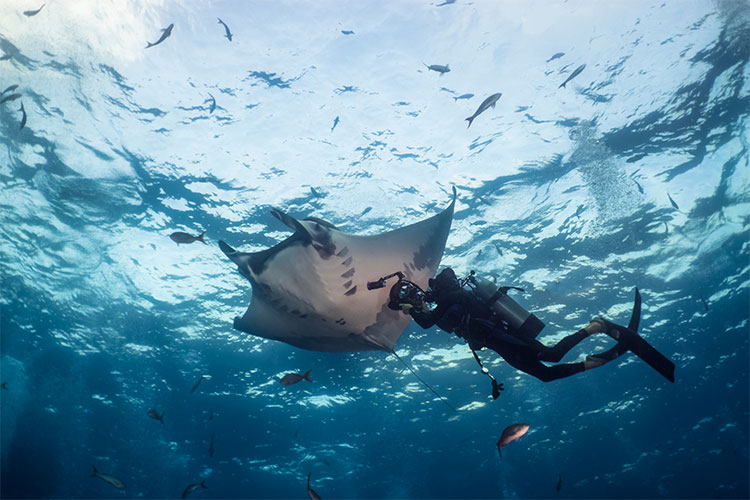
REVILLAGIGEDO ISLANDS, MEXICO
Commonly known as Socorro, the Revillagigedo Island chain is an archipelago made up of four volcanic islands off the coast of Baja California. These islands are world-renowned for big-animal encounters, offering near-guaranteed sightings of dancing manta rays, sleek sharks in a variety of species, playful dolphins, and more. These isolated islands are Mexico’s largest marine protected area, which means that the underwater scene remains one of the most unspoiled dive sites in the world. As a result, diving in Socorro is accessible only via liveaboard, creating the ultimate dive trip for those seeking adventure.
Divers visiting in February are often treated to encounters with humpback whales, who grace the islands with their presence from December through April. The second month of the year is also peak timing to see hammerhead sharks, mantas, and whale sharks.
Revillagigedo Islands Can’t Miss Dive Sites:
The Boiler: Located in San Benedicto, the Boiler is named for its surface swell that gives the appearance of boiling water. The site serves as a cleaning station for mantas, which flock to the area en masse. Even better, these massive creatures are incredibly curious, and often linger within feet of divers.
Cabo Pearce: On the east coast of Socorro Island, Cabo Pearce is a favorite among divers thanks to friendly dolphins that frequent the site. Encounters with hammerheads, silky sharks and mantas are common, but it’s the chance to see humpback whales that sets this site apart.
Roca Partida: Sheer walls and big animal encounters await divers at Roca Partida, which is named for its split pinnacle marking the dive site. Roca Partida is like a magnet for pelagics, making it a favorite for divers. As you hang in the blue, schooling hammerheads and thousands of yellowfin tuna are frequent visitors, and encounters with curious mantas are also on the menu.
Travel Tip: Socorro is only accessible via Liveboard, which makes for an incredible all-inclusive dive experience! Be sure to check travel itineraries for operators with trips in February to maximize your chances of humpback whale encounters.
Dive Conditions: Water temperatures in February range from the low-to-mid 70s, and topside temperatures are typically in the mid-70s during the day. Visibility ranges from 50-150 feet year-round. Be prepared for ripping currents and strong surge.
Essential Gear: If you’ve been looking for an excuse to upgrade your regulator, a trip to the Socorros is it. The advanced dive conditions mean that you’ll want a reg with superior performance, and we suggest the MK25 EVO BT/G260 Carbon. Pacific water temperatures mean you’ll want a thick wetsuit, and we recommend the Everflex Steamer in 5/4mm for divers used to the cold or the Everflex Steamer in 7/5mm for divers used to more tropical conditions. Please note that wearing gloves in the Socorros is illegal, so leave yours at home.
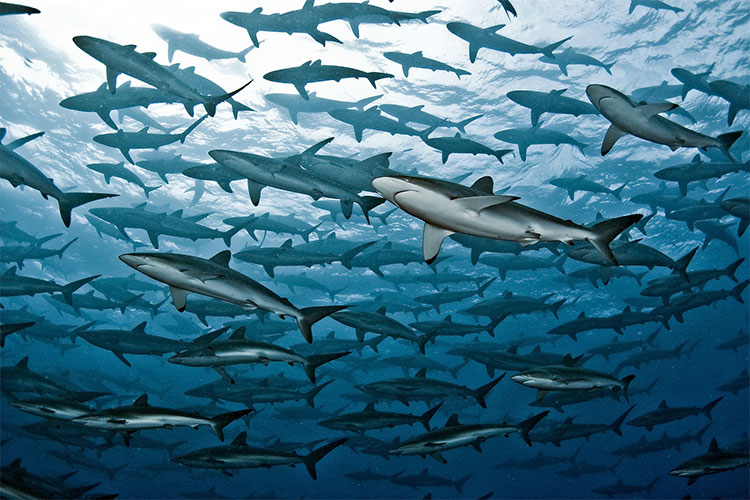
MALPELO ISLAND, COLOMBIA
If you’re looking for epic shark encounters, Malpelo Island delivers in spades. Located off the Colombian Mainland, Malpelo Island is part of the Malpelo Fauna and Flora Marine Sanctuary, which is one of the largest no-fishing zones in the Eastern Tropical Pacific Ocean. Thanks to its protected status, Malpelo’s diverse ecosystem remains virtually untouched, offering divers a first-hand look at apex predators in their natural state.
The area is prone to strong currents and surge, so an advanced certification is recommended. But divers up to the challenge are in for an epic adventure unlike any other, and visiting in February offers the best chance to see hundreds of schooling hammerhead and silky sharks. The island is also one of the few places in the world where divers can spot a short-nosed ragged-tooth shark, and other species include Galapagos, whitetip, and smalltooth sand tiger sharks. Apex predators aren’t the only draw of this Colombian gem: schooling angelfish, jacks, free-swimming moray eels, and giant grouper are among Malpelo’s residents.
Mapelo Island Can’t Miss Dive Sites:
Hammerhead Triangle: Formed by the corners of Cocos, Galapagos, and Malpelo, the Hammerhead Triangle is a must-do dive. Hammerhead sharks school en masse in the imaginary triangle, and the rocky formations are home to barberfish and clarion angelfish who provide cleaning services to the apex predators. Strong currents and staggering depths make this site exclusive to advanced divers, and it’s accessible only by liveaboard.
La Nevera (aka “The Fridge”): Abundant cleaner fish draw schools of scalloped hammerheads and Galapagos sharks consistently to this site, making encounters with the apex predators a near-guarantee. The rocky reef is sparse, but you won’t notice: the cleaning station also draws eagle rays and the occasional bottlenose dolphins for an epic big-animal encounter.
3 Musketeers: Named for its three stunning rock locations, this iconic site can’t be missed. Beneath the surface, divers can explore the “cathedral” swimthrough among schools of big eye jacks, silky sharks and Galapagos sharks.
Travel Tip: The only way to visit Malpelo Island is by liveaboard, and divers can expect a 30-to-40 hour trip from the mainland before reaching the dive site. Don’t let the travel time keep you from the journey: experiencing Malpelo is worth the wait.
Dive Conditions: Malpelo is known for its strong currents and challenging conditions, so advanced certification is required. Water temperatures average between 59 and 68 degrees, so thick wetsuits or drysuits are encouraged. Topside temperatures average in the 70s in February, and visibility can vary based on the high concentration of plankton this time of year.
Essential Gear: Challenging conditions mean keeping a close eye on your essential dive data, and a technical diving computer like Aladin A2 is essential. To keep warm during your bottom time, we recommend either the Evertech Dry Breathable Drysuit or the NovaScotia Semi-Dry 7.5mm.






